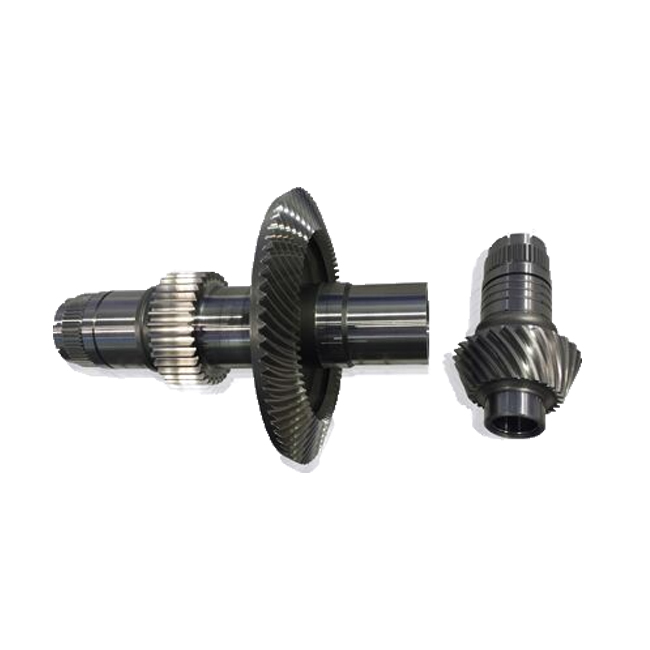High-speed gear transmission design is one of the most challenging areas in mechanical power transmission. Its core lies in balancing dynamic behavior, thermodynamic effects, and material limits under high-speed operating conditions. The following content presents a systematic overview from two dimensions: key design principles and empirical engineering data.
I. Core Principles in High-Speed Gear Design
1. Material Selection & Surface Engineering
Ultimate Strength Matching: High-toughness carburizing steels such as 18CrNiMo7-6 are recommended. Surface hardness should reach HRC60–62 with a carburized case depth of 1.2–1.8 mm. Core hardness should be maintained at HRC35–40 to withstand impact loads.
Surface Integrity Control: Post-grinding shot peening is necessary (coverage rate 200%+, Almen intensity 0.3–0.5 mmA) to reduce root stress concentration factors to below 1.3.
Anti-Scuffing Treatments: DLC coatings (thickness 2–3 μm) can increase the PV value limit by over 30%, suitable for line speeds exceeding 80 m/s.
2. Tooth Profile Dynamic Optimization
Profile Modification Algorithms:
- Thermo-elastic Deformation Compensation: Should be based on FEA thermodynamic analysis. A typical modification amount = 0.5 × (δ_thermal + δ_elastic), where δ_thermal ≈ 0.02 × module × ΔT / 100.
- Dynamic Profile Modification: Use parabolic + high-order harmonic superposition methods. Maximum modification can reach 15 μm for a module of 3.
Pressure Angle Optimization: A 25° pressure angle reduces contact stress by 12% compared to the standard 20°, but the contact ratio ε should be adjusted to exceed 2.1.
3. Lubrication System Design
Oil Jet Parameter Calculation:
Oil flow rate:
Q = 0.6 × b × m × n / 10000
(Unit: L/min, where b = face width in mm, m = module, n = speed in rpm)
Injection angles should ensure formation of an oil wedge:
Recommended: 30° ±5° on the drive side, 45° ±5° on the coast side.
Innovative Lubrication Approaches: Minimum Quantity Lubrication (MQL) systems with oil mist droplet size between 5–20 μm can reduce oil usage to 1/10th of traditional jet systems.
4. Dynamic Behavior Control
Modal Tuning: Adjust mass-stiffness matrix to keep the first torsional mode frequency at least 25% away from the gear mesh frequency.
Damping Configuration: Squeeze-film dampers can increase system damping ratio to 0.08–0.12, reducing vibration amplitude by 40%.
II. Key Empirical Parameter Database
1. Speed Classification Thresholds
| Operating Class | Line Speed (m/s) | RPM Range | Typical Application |
|---|---|---|---|
| High-Speed | 25–60 | 8,000–15,000 | Steam turbines |
| Ultra High-Speed | 60–120 | 15,000–30,000 | Aerospace APU |
| Extreme High-Speed | 120–250 | 30,000–60,000 | Micro gas turbines |
2. Optimal Geometric Parameters
Module vs. Speed Matching:
- m = 0.5–1 (for v > 100 m/s)
- m = 1–3 (for v = 60–100 m/s)
- m = 3–5 (for v < 60 m/s)
Helix Angle Optimization:
- β = 15° ±2° for vibration minimization
- β = 25°–30° for load-carrying maximization
Profile Shift Coefficient:
- x₁ + x₂ ≥ 0.5 (to avoid undercut)
- Single-side shift ≤ 0.6
3. Failure Mode Thresholds
Scuffing Risk:
Critical when flash temperature ΔT_flash > 150°C.
Formula:
ΔT_flash = μ × Ft / (b × cosα) × √(v / ρc)
(μ: friction coefficient, Ft: tangential force, b: face width, α: pressure angle, ρc: thermal diffusivity)
Micropitting Warning:
When surface roughness Ra > 0.4 μm, contact fatigue life decreases by 50%.
4. Manufacturing Tolerance Control
Precision Grade Recommendations:
- ISO Grade 3 (for v > 80 m/s)
- ISO Grade 4 (for v = 40–80 m/s)
Critical Tolerances:
- Total pitch deviation ≤ 5 μm (module = 3)
- Lead crown: Cβ = 0.005 × b (in mm)
III. Frontier Technologies
- Digital Twin Monitoring: Embedded fiber Bragg grating sensors for real-time tooth surface stress tracking.
- Gradient Material Manufacturing: Laser cladding enables hardness gradients (e.g., surface HV750 → core HV450).
- Supercritical Lubrication: Supercritical CO₂ fluid can reduce friction coefficients to 0.02 at 150 m/s.
High-speed gear design has transitioned from empirical methods to precision design based on multi-physics coupling. A recommended development process is the V-cycle model: virtual prototyping (CAE) → process simulation (CAM) → closed-loop real-world validation. Special attention should be given to the coupling effects of thermodynamics and dynamics during design. Optimizing in only one discipline may cause cross-scale failure issues.
Thank you for reading. We are looking forward to serving you with our exceptional gear solutions. #BeyondGears
Read More:


